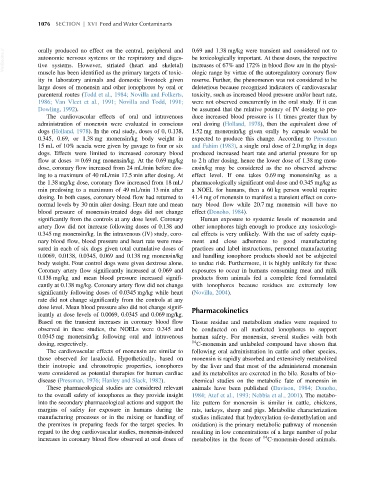Page 1144 - Veterinary Toxicology, Basic and Clinical Principles, 3rd Edition
P. 1144
1076 SECTION | XVI Feed and Water Contaminants
VetBooks.ir orally produced no effect on the central, peripheral and 0.69 and 1.38 mg/kg were transient and considered not to
be toxicologically important. At these doses, the respective
autonomic nervous systems or the respiratory and diges-
increases of 67% and 172% in blood flow are in the physi-
tive systems. However, striated (heart and skeletal)
muscle has been identified as the primary targets of toxic- ologic range by virtue of the autoregulatory coronary flow
ity in laboratory animals and domestic livestock given reserve. Further, the phenomenon was not considered to be
large doses of monensin and other ionophores by oral or deleterious because recognized indicators of cardiovascular
parenteral routes (Todd et al., 1984; Novilla and Folkerts, toxicity, such as increased blood pressure and/or heart rate,
1986; Van Vleet et al., 1991; Novilla and Todd, 1991; were not observed concurrently in the oral study. If it can
Dowling, 1992). be assumed that the relative potency of IV dosing to pro-
The cardiovascular effects of oral and intravenous duce increased blood pressure is 11 times greater than by
administration of monensin were evaluated in conscious oral dosing (Holland, 1978), then the equivalent dose of
dogs (Holland, 1978). In the oral study, doses of 0, 0.138, 1.52 mg monensin/kg given orally by capsule would be
0.345, 0.69, or 1.38 mg monensin/kg body weight in expected to produce this change. According to Pressman
15 mL of 10% acacia were given by gavage to four or six and Fahim (1983), a single oral dose of 2.0 mg/kg in dogs
dogs. Effects were limited to increased coronary blood produced increased heart rate and arterial pressure for up
flow at doses $ 0.69 mg monensin/kg. At the 0.69 mg/kg to 2 h after dosing, hence the lower dose of 1.38 mg mon-
dose, coronary flow increased from 24 mL/min before dos- ensin/kg may be considered as the no observed adverse
ing to a maximum of 40 mL/min 17.5 min after dosing. At effect level. If one takes 0.69 mg monensin/kg as a
the 1.38 mg/kg dose, coronary flow increased from 18 mL/ pharmacologically significant oral dose and 0.345 mg/kg as
min predosing to a maximum of 49 mL/min 13 min after a NOEL for humans, then a 60 kg person would require
dosing. In both cases, coronary blood flow had returned to 41.4 mg of monensin to manifest a transient effect on coro-
normal levels by 30 min after dosing. Heart rate and mean nary blood flow while 20.7 mg monensin will have no
blood pressure of monensin-treated dogs did not change effect (Donoho, 1984).
significantly from the controls at any dose level. Coronary Human exposure to systemic levels of monensin and
artery flow did not increase following doses of 0.138 and other ionophores high enough to produce any toxicologi-
0.345 mg monensin/kg. In the intravenous (IV) study, coro- cal effects is very unlikely. With the use of safety equip-
nary blood flow, blood pressure and heart rate were mea- ment and close adherence to good manufacturing
sured in each of six dogs given total cumulative doses of practices and label instructions, personnel manufacturing
0.0069, 0.0138, 0.0345, 0.069 and 0.138 mg monensin/kg and handling ionophore products should not be subjected
body weight. Four control dogs were given dextrose alone. to undue risk. Furthermore, it is highly unlikely for these
Coronary artery flow significantly increased at 0.069 and exposures to occur in humans consuming meat and milk
0.138 mg/kg and mean blood pressure increased signifi- products from animals fed a complete feed formulated
cantly at 0.138 mg/kg. Coronary artery flow did not change with ionophores because residues are extremely low
significantly following doses of 0.0345 mg/kg while heart (Novilla, 2004).
rate did not change significantly from the controls at any
dose level. Mean blood pressure also did not change signif- Pharmacokinetics
icantly at dose levels of 0.0069, 0.0345 and 0.069 mg/kg.
Based on the transient increases in coronary blood flow Tissue residue and metabolism studies were required to
observed in these studies, the NOELs were 0.345 and be conducted on all marketed ionophores to support
0.0345 mg monensin/kg following oral and intravenous human safety. For monensin, several studies with both
dosing, respectively. 14 C-monensin and unlabeled compound have shown that
The cardiovascular effects of monensin are similar to following oral administration in cattle and other species,
those observed for lasalocid. Hypothetically, based on monensin is rapidly absorbed and extensively metabolized
their inotropic and chronotropic properties, ionophores by the liver and that most of the administered monensin
were considered as potential therapies for human cardiac and its metabolites are excreted in the bile. Results of bio-
disease (Pressman, 1976; Hanley and Slack, 1982). chemical studies on the metabolic fate of monensin in
These pharmacological studies are considered relevant animals have been published (Davison, 1984; Donoho,
to the overall safety of ionophores as they provide insight 1984; Atef et al., 1993; Nebbia et al., 2001). The metabo-
into the secondary pharmacological actions and support the lite pattern for monensin is similar in cattle, chickens,
margins of safety for exposure in humans during the rats, turkeys, sheep and pigs. Metabolite characterization
manufacturing processes or in the mixing or handling of studies indicated that hydroxylation (o-demethylation and
the premixes in preparing feeds for the target species. In oxidation) is the primary metabolic pathway of monensin
regard to the dog cardiovascular studies, monensin-induced resulting in low concentrations of a large number of polar
increases in coronary blood flow observed at oral doses of metabolites in the feces of 14 C-monensin-dosed animals.

